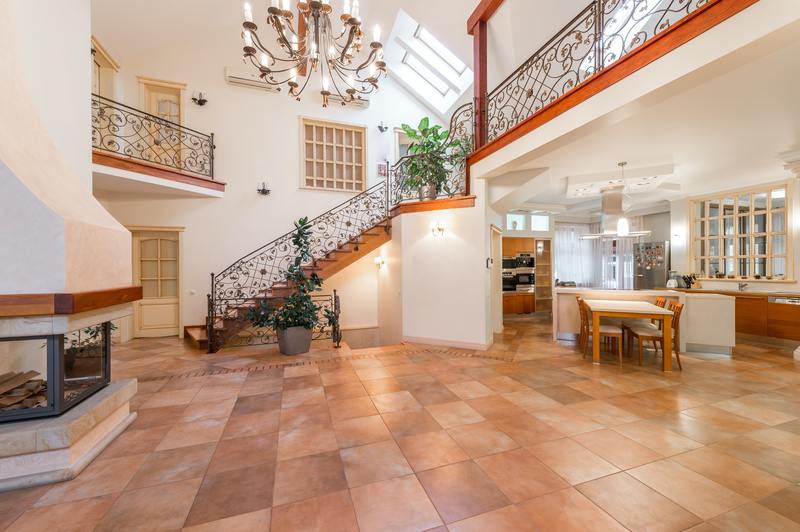Remove all the damaged tiles and replace them with pieces of the same size. This is how to replace water damaged luxury vinyl tile.
The specifics depend on the type of floor you have, floating or glued, but the process is pretty straightforward. These floors are popular for every home, so it’s essential to learn these tips.

What Is Luxury Vinyl?
Vinyl is synthetic flooring that homeowners love. It’s durable, cost-friendly, and one of the easiest floors to install.
This sheet comes in several styles, but luxury vinyl is the most popular. Luxury vinyl planks look and feel like natural flooring, so you think you’re standing on actual wood or stone. It gives the home a rustic look without a huge expense.
The Benefits Of Vinyl Flooring
People love vinyl floors for several reasons; it’s a valuable and versatile material that will make your home beautiful.
1. It’s comfortable
Luxury vinyl may look like natural flooring, but it’s smoother and more comfortable for your feet. It’s also a quiet material so it won’t make noise when you’re walking on it.
2. It’s mostly water-resistant
Floods and massive leaks will definitely damage your floor, but small spills aren’t anything to worry about. The synthetic material is waterproof and easy to clean.
3. It’s economical
Vinyl is affordable and easy to apply, so you won’t have to get professional help. It’s also durable, so your repair expenses will be minimal.
Step-By-Step Process On How To Fix Water Damaged Vinyl
Luxury vinyl is durable and most waterproof, but it can still be damaged by floods and leaks. Repairing the flooring is simple; you just need to know what type it is.
Water damage usually comes from the subfloor, and it will cause your tiles to swell. It’s essential to test the moisture level of the ground before you apply the pieces.
Method #1. Floating vinyl floors
Floating vinyl floors usually don’t need any adhesive; they are placed straight on the subfloor. It’s thicker and heavier than glue-down, so it’s a popular choice for homes.
Step #1. Determine which part of the wall is closest to the damaged tiles
Using the wall as a guide will save you from removing several pieces until you reach the damaged ones.
Step #2. Remove the molding
The molding or “baseboard” is around the wall perimeter. Now you can start removing the planks.
Step #3. Remove the damaged tiles
You may have to work your way in through all the tiles still in good shape until you reach the damaged parts.
Step #4. Apply the new tiles
Make sure the new pieces are the same size as the previous, then return the other tiles.
Step #5. Return the baseboard
Once you finish, you can return the molding, and your floors will look perfect!
Method #2. Glue-down vinyl floors
This vinyl tile uses adhesive to stick it to the ground. It’s stable, and the floor won’t move around too much.
Step #1. Remove the damaged tiles
Use a sharp knife or another tool to remove the swollen tiles.
Step #2. Clean the vacant area
Remove the old adhesive with a scraper and clean the surrounding area.
Step #3. Apply new adhesive
Use a brush or paint roller for applying new adhesive. Let it dry for a while until it feels tacky.
Step #4. Put the new tile and clean up
Make sure you press down the new piece, so it sticks well, then clean around it with a rag.
It’s essential to check your subfloor before repairs. Make sure there isn’t any moisture, and there will be no more leaks.
Tips For Vinyl Floor Care
This sturdy flooring can handle all spills, and repairing it is easy. However, you must still take precautions when cleaning your tiles to avoid getting damaged again.
Dry cleaning
It’s best to use a dust mop when you dry clean your tiles. This cleaning will remove all the dust and debris that build upon it. Use soft material when cleaning the floor so it doesn’t get scratched.
Wet cleaning
Several solutions can clean your floor well, but you could also try a homemade apple cider vinegar cleaning agent. Remember to wring the mop well even if the flooring is waterproof.
Things to avoid
Luxury vinyl floors are sturdy, but there are some cleaning agents you must avoid.
- Ammonia-based products – This abrasive cleaner can cause ugly stains that can’t be removed.
- Rubber pads – Your best choice for cleaning vinyl floors is felt. The rubber can damage the floor and cause friction. The chemicals in rubber can also stain your tiles.
Will Insurance Cover Your Damaged Luxury Vinyl?
Sometimes the damage is too severe for a simple D.I.Y. to handle. Major flooding will make the whole floor damaged, and you will need to refurbish it.
This concern can be costly and time-consuming. Do you think your insurance policy will be able to help you?
Luckily, vinyl floors fall under buildings insurance. This policy includes the cost of building every part of your home.
Damage from floods and burst pipes are part of the insurance coverage. Floorings that are glued have a higher chance of being approved by the company, so try to stick with glue-down vinyl floors. Just remember to review your policy and consult with your lawyer if you have any questions.
Conclusion
Quality flooring is an excellent investment in your home, but sometimes it can get damaged. You can save your home if you know how to replace water damaged luxury vinyl tile. Your beautiful floor will be back to normal!
